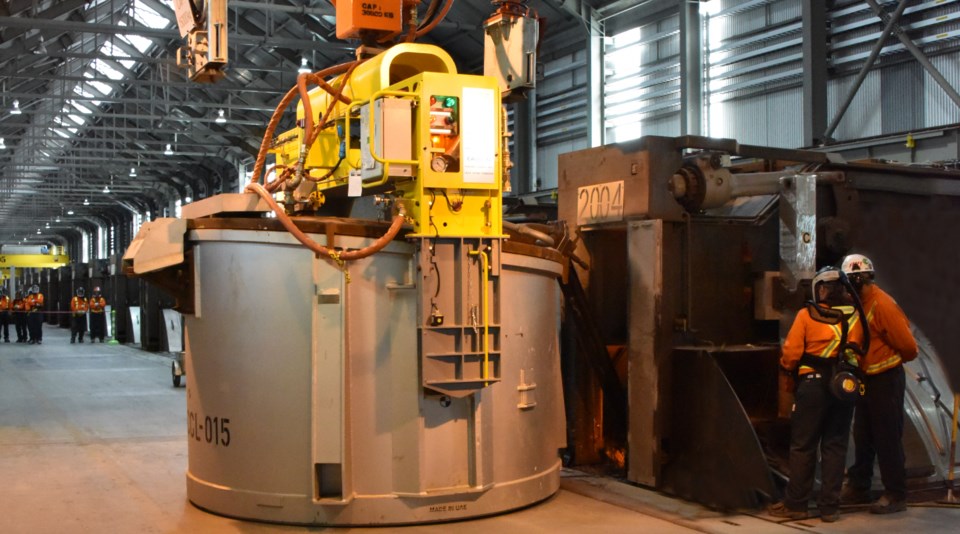As the fourth-largest producer of aluminum in the world, Canada is justifiably worried about the economic impacts of 25-per-cent tariffs on steel and aluminum exports to the U.S.
B.C. is also justifiably concerned as a producer of unwrought aluminum, though perhaps not as concerned as Quebec, which is Canada’s largest aluminum producer, with eight of the country’s nine aluminum smelters.
At the time of writing, tariffs on U.S.-bound exports of both products will go into effect March 12.
B.C. has no steel industry to speak of, but it does produce aluminum. The Rio Tinto BC Works smelter in Kitimat employs 1,130 workers and contributes $500 million annually to the provincial economy.
B.C. has seen this movie before, though the sequel promises more action and more conflict, as anticipated tariffs coincide with inflation, and the risk of retaliatory tariffs imposed by Canada should the U.S. proceed with across-the-board tariffs on Canadian goods.
The provincial aluminum industry is highly exposed to the U.S. In 2024, aluminum exports from B.C totalled $1.3 billion, with $1.1 billion of that going to the U.S., according to BC Stats.
During his first term in office, U.S. President Donald Trump in 2018 imposed 25-per-cent tariffs on steel and 10-per-cent tariffs on aluminum imported from Canada—a move aimed at protecting and bolstering the American steel and aluminum industry.
The tariffs were in place for a little over a year before Canada and other trade partners got an exemption.
After the tariffs were imposed, the total value of exports of aluminum from B.C. was cut in half over the next two years, dropping from $1.3 billion in 2018 to $615 million in 2020. The global pandemic that caused a broad economic contraction was undoubtedly a contributing factor to the decline.
Despite the value of exports to the U.S. declining during this period, the tariffs may have created a new market for B.C. aluminum in Europe.
Whereas no aluminum went from B.C. to the European Union from 2014 to 2017, B.C. began selling into the EU in 2018, and has exported about $240 million worth of unwrought aluminum to the EU every year since, with the exception of 2022.
According to the White House, the tariffs had their intended effect by at least temporarily boosting U.S. aluminum production.
“These measures were remarkably effective in supporting recovery and reinvestment in the American steel industry and saved the domestic primary aluminum industry from total collapse,” a White House fact sheet states. “But exemptions and loopholes have permitted evasion of the tariffs and weakened the effectiveness of the program.”
The utilization rate of U.S. aluminum production capacity rose from 40 per cent in 2017 to 61 per cent in 2019, the White House fact sheet states, but then steadily declined again after 2019, when Canada and other countries received tariff exemptions.
For Rio Tinto, the tariffs appeared not to have had a major impact on the company’s overall bottom line. The global diversified mining company reported that earnings from its aluminum division—which includes bauxite mining, refining and smelting—were 10 per cent lower in 2018 compared to 2017.
“Our aluminium business was stable from an operational perspective, with higher premiums for our sales in North America offset by the U.S. 10-per-cent tariff,” the company said in its 2018 annual report.
Automobile manufacturing is the single-largest sectoral user of aluminum in the U.S, with electric vehicles using two to three times as much aluminum as conventional gas-powered vehicles. The growth of EVs is a primary driver of the increasing demand for aluminum which, according to the International Aluminium Institute, is expected to grow by 80 per cent globally through to 2050.
As such, U.S. automakers are worried about how tariffs—including those imposed on aluminum and steel—will drive production costs up. They can be counted on to lobby for Canadian exemptions.
At a February 11 Wolfe Research conference, Ford CEO Jim Farley reportedly said that Trump’s tariff threats were causing “a lot of cost and a lot of chaos” for his company.
Even the U.S.-based Aluminum Association appears to be urging some restraint in the use of tariffs. The main target of trade protection measures should be China—the world’s largest producer of aluminum and steel.
In a presidential brief, the association argued for “targeted trade enforcement” to protect aluminum manufacturers in the U.S. from “Chinese and other non-market actors.”
“China has supported its domestic aluminum industry with more than $60 billion in government subsidies in recent years, according to analysis by the Organisation for Economic Cooperation and Development (OECD). But trade enforcement must be targeted,” the association wrote.
“Today, the U.S aluminum industry can only supply about one-third of the primary aluminum it needs to meet demand. That means we must rely on imports of primary aluminum from Canada and other market economies.”
Among the organization’s recommendations to Trump are measures to reinforce the supply chains that will “ensure America’s aluminum manufacturing dominance, starting with vital partners like Canada.”



